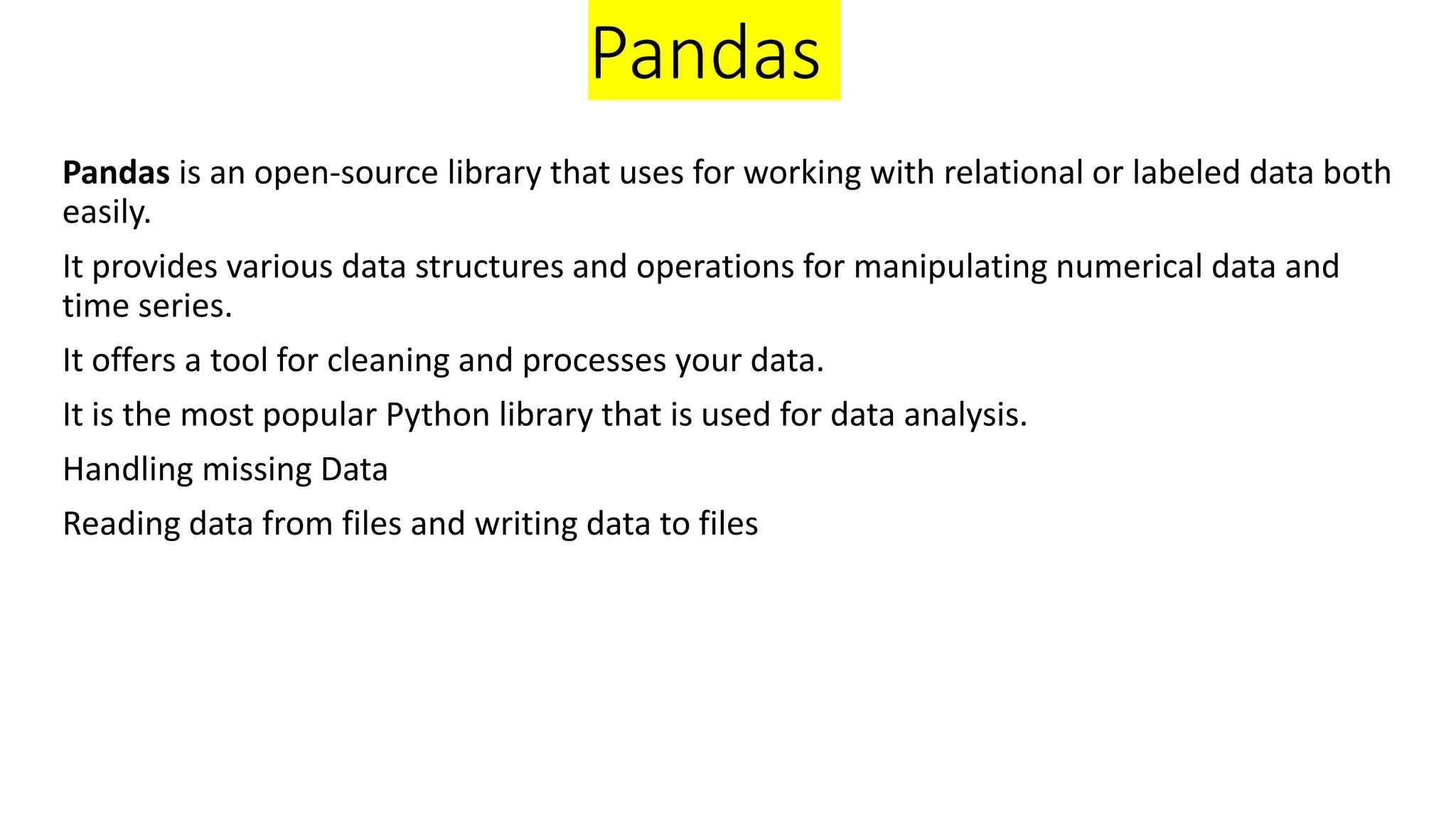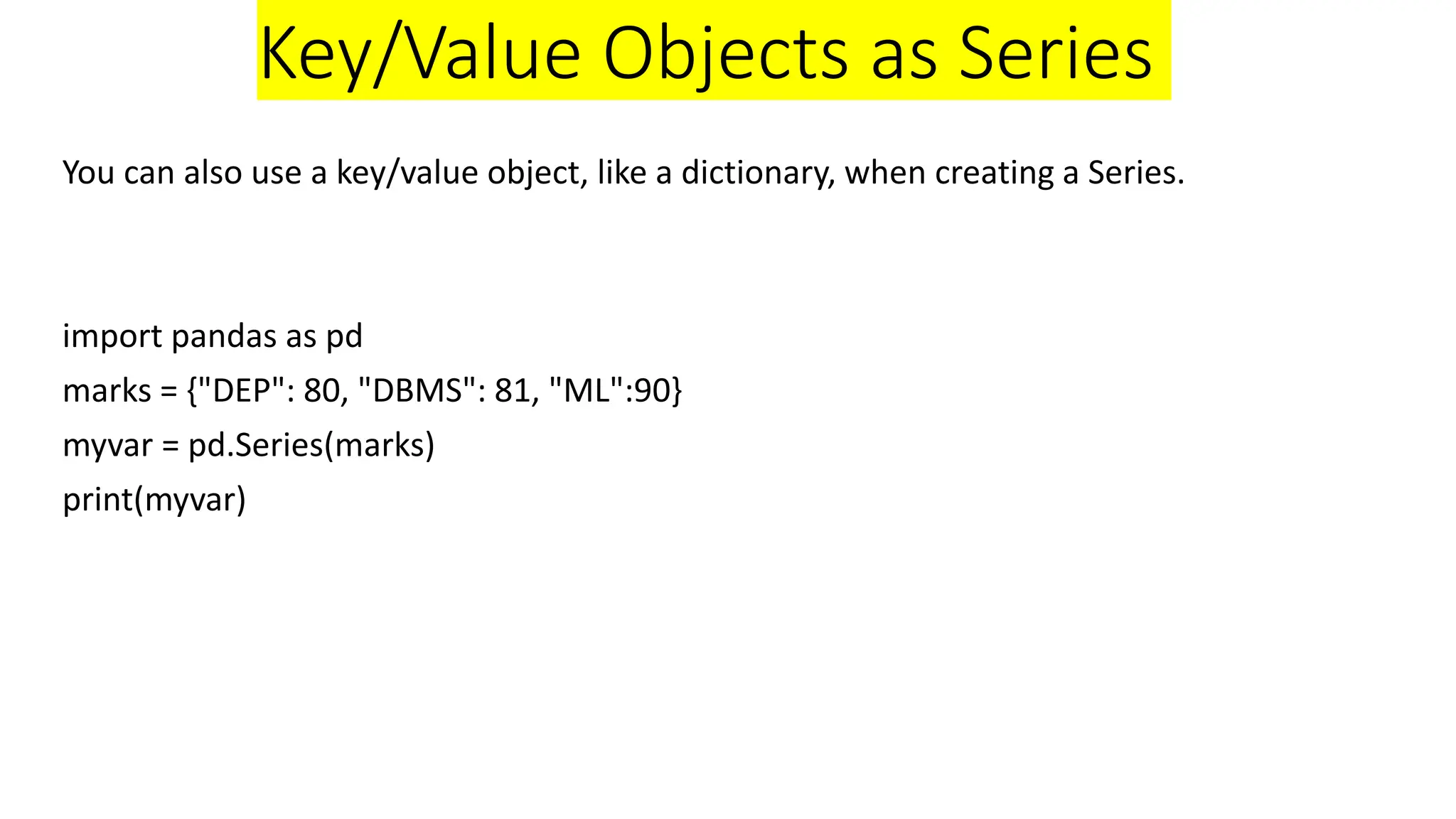Pandas is an open-source Python library for data manipulation and analysis, particularly effective for relational or labeled data. It provides structures like Series and DataFrame for efficient data representation and operations, including handling missing data and data cleaning. The library's clear API and various functions, such as standard deviation calculation and mapping values, enhance usability for data analysis tasks.


![Series
A Pandas Series is like a column in a table.
It is a one-dimensional array holding data of any type.
Pip install pandas
import pandas as pd
a = [1, 3, 8,9,7]
myvar = pd.Series(a)
print(myvar)](https://image.slidesharecdn.com/seriesdatastructureinpandas-240801064617-a0fdfd92/75/Series-data-structure-in-Python-Pandas-pptx-3-2048.jpg)
![Pandas
INDEX
import pandas as pd
a = [1, 3, 2,’AVANTHI”]
myvar = pd.Series(a)
print(myvar[0])](https://image.slidesharecdn.com/seriesdatastructureinpandas-240801064617-a0fdfd92/75/Series-data-structure-in-Python-Pandas-pptx-4-2048.jpg)
![Create Labels
With the index argument, you can name your own labels.
import pandas as pd
a = [2, 8, 2]
myvar = pd.Series(a, index = ["x", "y", "z"])
print(myvar)
#print(myvar["y"])](https://image.slidesharecdn.com/seriesdatastructureinpandas-240801064617-a0fdfd92/75/Series-data-structure-in-Python-Pandas-pptx-5-2048.jpg)

![Retrieve
To select only some of the items in the dictionary, use the index argument and specify only
the items you want to include in the Series.
import pandas as pd
marks = {"DEP": 80, "DBMS": 81, "ML":90}
myvar = pd.Series(marks, index = ["DEP", "ML"])
print(myvar)](https://image.slidesharecdn.com/seriesdatastructureinpandas-240801064617-a0fdfd92/75/Series-data-structure-in-Python-Pandas-pptx-7-2048.jpg)
![Find datatype and length
import numpy as np
import pandas as pd
a=pd.Series(data=[1,2,3,4])
b=pd.Series(data=[4.9,8.2,5.6],
index=['x','y','z'])
print(a.dtype)
print(a.itemsize)
print(b.dtype)
print(b.itemsize)](https://image.slidesharecdn.com/seriesdatastructureinpandas-240801064617-a0fdfd92/75/Series-data-structure-in-Python-Pandas-pptx-8-2048.jpg)
![map
Pandas Series.map()
The main task of map() is used to map the values from two series that have a common
column.
Syntax:
Series.map(arg, na_action=None)
import pandas as pd
import numpy as np
a=pd.Series(['Java','C','C++',np.nan])
a.map({'Java':'Core'})
s=a.map('I like {}'.format,na_action='ignore')
print(s)](https://image.slidesharecdn.com/seriesdatastructureinpandas-240801064617-a0fdfd92/75/Series-data-structure-in-Python-Pandas-pptx-9-2048.jpg)
![STD()
Pandas Series.std()
The Pandas std() is defined as a function for calculating the standard deviation of the given
set of numbers, DataFrame, column, and rows
import pandas as pd
# calculate standard deviation
import numpy as np
print(np.std([4,7,2,1,6,3]))
print(np.std([6,9,15,2,-17,15,4]))](https://image.slidesharecdn.com/seriesdatastructureinpandas-240801064617-a0fdfd92/75/Series-data-structure-in-Python-Pandas-pptx-10-2048.jpg)